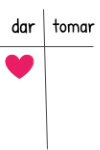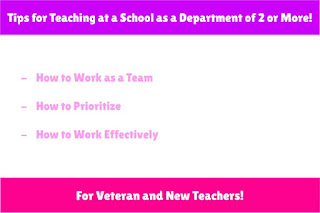PLAYING THE UNFAIR GAME IN SPANISH CLASS
THE UNFAIR GAME IN SPANISH CLASS:
3 Minute Read:
Something I honestly look forward to is getting to play the Unfair Game in Spanish class. It’s a highly engaging game, that I use to review grammar concepts and to summarize chapters from a book we’ve been reading in class. There’s a lot of variations of how the Unfair Game works, and here’s my take on it!Take my Spanish Past Perfect Unfair Game for example:
.png)
This version of the Unfair Game is meant to be played by just clicking the slides in order. (Some of my other Unfair Games have a Menu, like my Telling Time Unfair Game).
There should be 2 teams, equipo verde y equipo morado.
.png)
Points are predetermined for each slide!
I always let students use their notes to help them, but you can decide that for your class.
It’s up to you if you want to allow “team talk”.
On a whiteboard, I usually draw a t-chart that says “Dar” and “Tomar” with a magnet to mark what the spokesperson decided. Between the time of the spokesperson deciding, the time it takes them to write answers, it’s a good tactic to not forget!
I also have a t-chart with Equipo Verde and Equipo Morado’s points

1) Divide your class into 2 teams. If possible, each player needs a whiteboard & marker. If not possible, a cheaper option is to use white paper inside page protectors with whiteboard markers.
2) Give each team time to select a spokesperson. If they can’t decide in a timely fashion, I pick for them. (usually an outgoing student, or a student that would benefit from being called on frequently😉)
3) To start, the Green Team’s spokesperson needs to decide “give” or “take” PRIOR to seeing the question.
4) Both teams should be attempting to answer. Within 1 minute (or less for the shorter slides) students should show you their board. I usually circulate the room and check as they’re answering, as it keeps the pace of things going smoothly.
5) When the majority of the team gets it correct, I click to reveal the answer. I usually draw either on the smartboard or a different whiteboard what people’s common errors were, and help them learn from their mistakes. I don’t mention who had it wrong, I say, “some of you had this, and you’re close but here’s why it should be this”.
6) Let’s say the majority of that team did NOT get it correct. Then I look at the other team’s answers. I usually give them a warning of “diez segundos más” and then I check their answers. Because they had more thinking time (and sometimes kids saw the other team’s answers), I say 100% of them need to get it correct. You could change that rule if you choose.
a. I tell them if the other team gets it correct, they get POSITIVE points, even if it shows a negative number. Perks for paying attention when it’s not really their turn!
7) Once either the original team got it correct, the other team, or neither, I click to reveal the points to show what it generated.
a. So if the original team got it correct, they chose to “give” and it shows -2, you subtract -2 points from the other team. Scores can go negative, and often do.
b. If the original team got it correct, they chose to “take” and it shows -2, you subtract -2 points from the original team. That’s what makes it UNFAIR!
c. If the original team did not get it correct, but 100% of the other team did, and it shows -2, you really GIVE the other team POSITIVE 2, because they were paying attention when it wasn’t really their turn.
8) This helps me with engagement. Even though I explain the rules as such, it usually takes 1 round for them to realize “oops, should’ve been paying attention”.
a. The team with the most positive points at the end wins!
b. A tiebreaker is included just in case, with specific rules included on that slide.
c. If there’s still a lot of game left and the bell is going to ring, I often write down on a post-it what slide we’re on, if the team answered that slide or not, and what both team’s points are. Then I pick the game up right where we left off the next class. It really does work out well!
Students will without fail, say something along these lines if their team is really in the negative: “Well aren’t we playing golf? So really we’re winning!” I always think it’s great how they think they’re being so funny.
If this game sounds like fun to you, check out the rest of my Unfair Games on TPT!
a. So if the original team got it correct, they chose to “give” and it shows -2, you subtract -2 points from the other team. Scores can go negative, and often do.
b. If the original team got it correct, they chose to “take” and it shows -2, you subtract -2 points from the original team. That’s what makes it UNFAIR!
c. If the original team did not get it correct, but 100% of the other team did, and it shows -2, you really GIVE the other team POSITIVE 2, because they were paying attention when it wasn’t really their turn.
8) This helps me with engagement. Even though I explain the rules as such, it usually takes 1 round for them to realize “oops, should’ve been paying attention”.
a. The team with the most positive points at the end wins!
b. A tiebreaker is included just in case, with specific rules included on that slide.
c. If there’s still a lot of game left and the bell is going to ring, I often write down on a post-it what slide we’re on, if the team answered that slide or not, and what both team’s points are. Then I pick the game up right where we left off the next class. It really does work out well!
Students will without fail, say something along these lines if their team is really in the negative: “Well aren’t we playing golf? So really we’re winning!” I always think it’s great how they think they’re being so funny.
If this game sounds like fun to you, check out the rest of my Unfair Games on TPT!

.jpg)